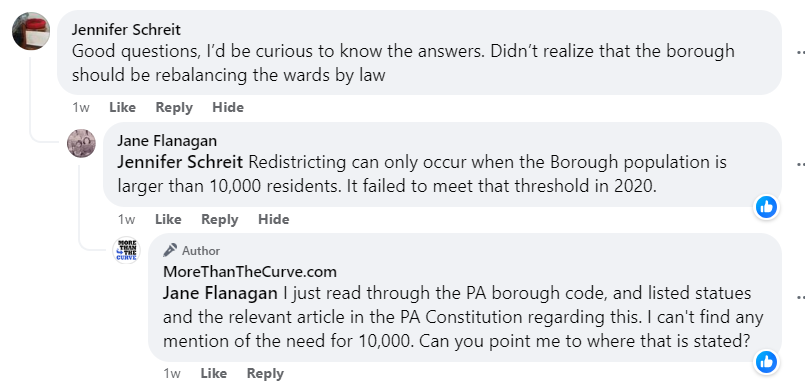As we have previously reported (almost exactly two years ago), the Borough of Conshohocken’s ward system is very unbalanced when it comes to population. The borough council has not taken the necessary steps to rectify this situation as it is required by law to at least consider every 10 years following the census.
The issue is now over a decade old (likely longer). There are dramatic differences in population and registered voters among the borough’s seven wards. With each ward having one representative, the residents of a ward with a large population are underrepresented on the borough council. The smaller wards are over represented.
The Pennsylvania Borough Code § 601 (d) Composition states “All wards in the borough shall be numbered and composed of compact and contiguous territory as nearly equal in population as practicable as officially and finally reported in the latest official census”.
In the 2010 census, there were 7,833 residents of the borough. That grew to 9,261 by the time of the 2020 census.
So lets look at some numbers. Below is a comparison of the number of registered voters by ward from the 2011 general election and the 2023 primary election (the latest numbers available from Montgomery County).
2011 General Election
Ward 1 – 1,180
Ward 2 – 320
Ward 3 – 1,093
Ward 4 – 1,024
Ward 5 – 746
Ward 6 – 779
Ward 7 – 703
Total Registration – 5,845
2023 Primary Election
Ward 1 – 1,480 (+300 over 2011)
Ward 2 – 309 (-11 from 2011)
Ward 3 – 1,386 (+293 over 2011)
Ward 4 – 1,135 (+111 over 2011)
Ward 5 – 853 (+107 over 2011)
Ward 6 – 807 (+28 over 2011)
Ward 7 – 694 (-9 over 2011)
Total Registration – 6,664
According to the 2020 (v 2022) census data, there are approximately 1,100 people under the age of 18 in the borough. That leaves approximately 1,500 adults who haven’t registered to vote unaccounted for. Obviously all the kids and unregistered adults don’t live in the smallest wards. They are likely spread out around the borough.
So why hasn’t the borough council acted?
Just prior to the 2023 general election we asked that question to Borough Council President Colleen Leonard (Ward 7), who was running as an incumbent. We did not receive a response (and she ended up losing the election).

However, a former member of the borough council, Jane Flanagan (2016-2021), who was supporting Leonard in the race, made a comment on Facebook when a reader brought up the issue. Flanagan offered that that the borough didn’t meet a threshold of 10,000 residents that is required to make a change.
We asked another member of borough council, Karen Tutino (7), about the issue and she also mentioned the 10,000 resident requirement.
What we have found is that there is no such requirement. This week we researched other boroughs in Pennsylvania that made a change to their ward system. Some did not have 10,000 residents. We also scoured all the pertinent laws. Nothing.
We also spoke with the borough manager of a municipality that recently went through the process. He did not know of any 10,000 resident requirement.
What we think likely happened is that there was a discussion about switching Conshohocken from a borough to a third-class city. There is a 10,000 resident requirement for that.
We also found out that borough councils don’t like making changes to the longstanding ward systems. The new system created can lead to those in office having to run in newly created wards or at-large wards. Potentially it can lead to long standing allies on the councils having to run against one another.
The borough staff and consultants who advise borough councils aren’t always keen for it either. A new makeup of a borough council can lead to staff changes and switching consultants. They could be out of a job.
The only question now is when will action be taken (or a demand from voters for it).
Let us know what you think in the comments.

